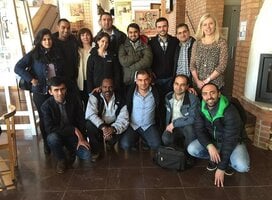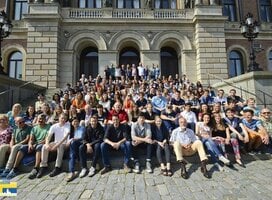Swedish Language Schools in Sweden
Why learn Swedish? Learning Swedish is essential not only to living in Sweden, but becoming integrated in the Swedish culture and life.
Swedish is a beautiful sounding language because of inflection and intonation, but for English speakers, it's simple to learn because of the grammar structure and link to English. The connection to the North-Germanic languages leaves anybody learning Swedish the open opportunity to ease into learning Danish, Norwegian, or German.
Swedish is only one aspect of the country of Sweden; Sweden is an incredible country that can accommodate anyone. From the far north where the Northern Lights are found in untouched wilderness, to the bustling cities on the stretch of islands and coast; to the exciting traditions and cuisine that are tied to the changing of the seasons, Sweden offers an incredible experience rich in culture, traditions and beauty.
The Swedish language can be simple to a student with a linguistic knack, but to most students, Swedish can prove to be a bit more difficult. But with a variety of different programs to choose from -- ranging from language study and cultural immersion to homestay -- finding the correct program will help greatly to honing your Swedish language skills to the point that you’ll be blending in with the Swedes and throwing your own crayfish party by the end of summer.
Cultural Immersion Programs
Many language immersion programs are tied to American-based universities, which makes earning and transferring university credits easy. Swedish immersion programs usually cover between 15-20 hours of intense language classes a week that cover reading, writing, speaking and listening exercises, as well as cultural and historical significant activities.
These programs prove to be intensive, but also highly successful; people willing to put in the hard work and plunge head first into the Swedish language and culture, then immersion programs will prove to be a perfect suit.
Group courses
Similar to language study and cultural immersion programs, group courses allow a more personal atmosphere with much smaller class sizes. Group courses also give flexibility with the pace of study.
These programs, however, rarely include cultural activities. If they are included, they are typically an added cost, which means that you usually have to organize or budget a cultural excursion. Group courses will be highly beneficial for people wanting a heavy focus on the Swedish language and culture as an afterthought.
University courses
As with the language immersions programs, university course units are simple to transfer, and applicable to a current major in an American-based university. Courses provided by a university in Sweden are primarily taught in English, unless a student takes a Swedish language course for the semester. Not to fret though, Swedish universities provide foreign learners with an opportunity to enroll in Swedish cultural and historical courses to further knowledge about Sweden.
For most of these classes, however, the Swedish language is a prerequisite due to the overall need of knowing the language to understand the culture, traditions, and history. University courses allow you to gradually build an understanding of the Swedish language, culture, and history while living within the country, allowing for a smooth transition into Sweden.
Homestay
Language learners participating in homestay programs will have the opportunity to experience the language and culture of Sweden firsthand ranging from 1-week to 2-months, with 15-30 lessons per week. You will experience a language course designed around their personal needs and wants of the Swedish language while benefiting in a more intimate and unique glimpse of Swedish life, culture and customs by living with a host family.
Most of these program styles, however, do not allow you the opportunity to obtain university credits, but instead serve as a personal experience to learn the Swedish language and lifestyle.
Private Tutoring
Similar to homestay, private tutoring allows people the opportunity to learn the Swedish language on an intimate and personal level. Private tutoring is for language learners of all levels, with focus being on what the you want to learn or improve. Students with full course loads at a university or unable to enroll in an immersion program benefit greatly from private tutoring.
Stockholm
The capital of Sweden serves as a popular destination for visitors and expats alike. Living and learning in the island created capital will prove to be an exciting experience filled with: historical tours into the past through such places as the Royal Palace, or visiting the warship Vasa.
Admire Skansen, the first open air museum of Sweden or be a child again in Junibacken, a Pipi Longstocking themed park. Then, round it all of by chowing down a traditional Swedish meal, or enjoying a night on the town.
People living in Stockholm will enjoy the bustling city with the relics of the past while learning the Swedish language and culture.
Lund
Lund University serves as one of the oldest universities in northern Europe, with nearly 3,000 international students enrolling at the university annually. Located in Southern Sweden, Lund allows students the ability to live in a modern town without the bustling atmosphere.
Lund is filled with a rich and deep historical and cultural significance to Sweden. The Domkyrkan, 12th century Cathedral, is well known for the Astronomical Clock that is comprised of knight figures marking the hours, phases of the moon and sun, and a calendar; Lund is home to Kulturen, the second oldest open-air museum, which displays traditional rural life in Sweden, as well as a botanical garden called Botan that stretches nearly 20 acres.
Malmö
Malmö was once known as the earliest industrialized towns in Scandinavia, but is now known primarily for it’s own university. Malmö University hosts up to 300 exchange students annually, which makes it quite competitive. But, for the students that are accepted, Malmö serves as an incredible backdrop to learning the Swedish language and culture.
Malmö is home to several buildings dating back to the 14th century, such as St. Peter’s Church, which show Danish influence in the Swedish history of architecture, as well as Danish castle, Malmöhus Slott, which includes an aquarium. Sankt Petri Kyrka, the oldest church there, displays medieval frescoes. People interested in Swedish architecture and culture will find Malmö a fitting place.
Gothenburg
Similar to the atmosphere of Lund, Gothenburg serves as a mellow atmosphere for students while being surrounded in history and culture while still ranking as Sweden’s second largest city. Although there are only two universities to choose from, Swedish learners will enjoy the big city, with a small town feel.
Umeå
Umeå University provides students with the opportunity to be involved in a truly international and multicultural educational experience.
Umeå’s location provides language learners with an opportunity to explore and experience the nature of Sweden; Umeå is far enough north to experience the Northern Lights, an untouched wilderness and summer nights that never seem to end.
Umeå also serves a cultural hub for music, hosting an annual Jazz Festival as well as being the birthplace of many punk and heavy metal bands. Swedish learners in Umeå will enjoy a modern city feel while being surrounded by the beauty of Sweden.
Sweden Highlights
- Population: 10+ million
- Native Swedish Speakers: 9 million
- Fun Fact: On Easter, children dress up as witches and go trick-or-treating.
- Schools out, lets have some fun: Swedish festivities and traditions reside in the changing of the seasons; make sure to dance around the maypole at Midsummer, chow down on crayfish at a kräftpremiär, crayfish party, and help ignite a Walpurgis fire to celebrate the coming of spring.
- Idiom: Hålla tummarna literally translates to "hold your thumbs", which is similar to cross your fingers.
Qualifications & Visas
Regardless of your Swedish language level, you will be able to find a course that suits your needs in Sweden. Sweden allows U.S. Citizens to be in the country without a visa for 90 days, which means for those people staying longer will require a residence permit before entering the country. These permits can be applied for at a Swedish consulate or embassy.
Group courses don’t require a university tie to an American university, which means this option is open to language learners of all ages. Homestay and private tutoring allows for students to learn Swedish privately and on an intimate level that university and group course students do not have.
Living in Sweden as an au pair, is another option to get assistance with learning Swedish.
Cultural Immersion & Extracurricular Activities in Sweden
Swedish language studies can make anyone feel like the four walls of a classroom are collapsing in, so cultural immersion and activities serves as a perfect fit to escape the classroom atmosphere while practicing and learning the language.
The Swedish language is linked directly to Swedish history; therefore learning more about the history allows Swedish learners to see how the Swedish language became established. Visit the Viking sight of Gamla in Gamla Uppsala, or one of many Swedish islands to see Viking stone ruins. Make local friends and try the food. Get immersed!
Financial Costs of Learning Swedish in Sweden
Sweden has a reputation for being one of the more expensive nations, but it's not too far off from the cost of living in a major American city. The average price of a beer is $7, and rent in the city center will run about $900 per month.
To save money, some people find their own apartments to share fees and expenses with other Swedish language students or visitors.
Host families typically have a fee built into costs, which usually includes 2-3 meals a day, as well as room and board.
Group courses are ideal for people who are already living in Sweden and have a small budget to spare, compared to private tutoring that usually tends to be a bit more expensive.
The best way to save money, however, is to shy away from big city living and settle into a smaller town.
Scholarships
For Swedish learners who are enrolled in a university, there are some scholarships that exist specifically to encourage the study of Nordic culture and language:
The American Scandinavian Foundation provides students wanting to study in Scandinavia an opportunity to compete and earn fellowships and grants, as well as providing students an alternative source of funding.
The Society for the Advancement of Scandinavian Studies works to further the studying and understanding of Scandinavia by providing students with fellowships and grants.
The American Women’s Club in Sweden funds an annual grant for an American woman studying in Sweden.
The Swedish Women’s Educational Association International, Inc. -- based in North Carolina -- provides a scholarship to prospective women wanting to study in Sweden.
We, at Go Overseas, have also compiled a list of general study abroad scholarships and grants for students of various education levels.
Contributed by Samantha Coughran
Swedish Language Programs in Sweden
Related Language Schools Articles
Frequently Asked Questions
-
Where can I learn Swedish in Sweden?
There are many fantastic cities and towns to learn Swedish in Sweden, but a few popular destinations include Stockholm, Lund, Malmö, Gothenburg, and Umeå.
-
Do you need to learn Swedish to live in Sweden?
Although most of Sweden speaks English, it's important to learn Swedish so you can get around and interact with the locals. Learning the language will also help you integrate into Swedish life and culture much faster.








